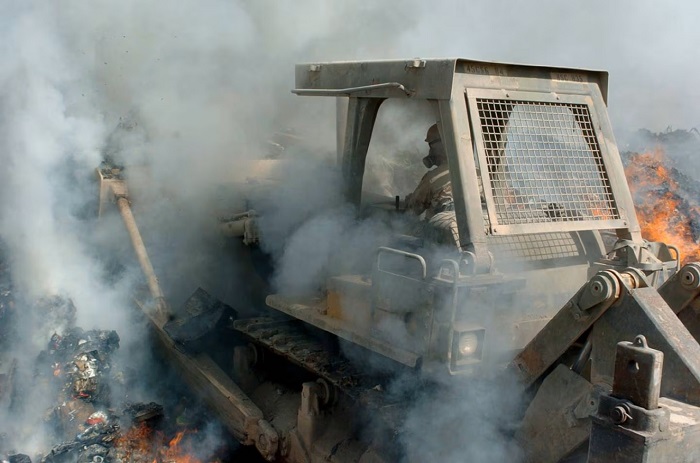Office of Research & Development |
 |


Logistics Support Area Anaconda, Balad, Iraq—Sgt. Richard Ganske, 84th Combat Engineer Battalion, pushes waste materials deep into a burn pit. (©28th Public Affairs Detachment)
May 31, 2024
By Erica Sprey
VA Research Communications
"VA is heavily invested in making sure that Veterans get the care and the benefits that they're entitled to."
In a first-of-its-kind study, a multi-institution team of researchers led by the Providence VA Medical Center and Brown University in Rhode Island found an increased risk for respiratory and cardiovascular conditions in Veterans exposed to open burn pits.
The innovative study, published in JAMA Network, connected declassified military deployment records with VA-documented health outcomes to form the largest group of Veterans to date to be studied in relation to burn pit exposures.
“Our work holds significance, in large part, because of the opportunity to study a large population of Veterans and combine Department of Defense (DoD) deployment data with VA health care data to address long-term consequences of military service,” said study author Dr. David Savitz, a professor of epidemiology at Brown University. “An important aspect of this study was that it created a model for future assessments of military exposures and long-term health outcomes.”
For every 100 days of burn pit exposure, researchers found a 1% increased risk for asthma, a 4% increased risk of chronic obstructive pulmonary disease (COPD), and a 5% increased risk of ischemic stroke in Veterans with documented deployments to bases in Afghanistan and Iraq. This group of Operation Enduring Freedom (OEF)/Operation Iraqi Freedom (OIF) Veterans also had an elevated risk of developing high blood pressure.
While Veterans’ the increased risk for developing respiratory or cardiovascular disease may seem relatively small, the average duration of exposure was 244 days, with 86% of the study group having some burn pit exposure. Given the dose-dependent relationship for exposures the team identified, all that time exposed can add up.
“These findings suggest that prolonged deployment to military bases with open burn pits may increase the risk of developing adverse health outcomes,” said Savitz. “Our results indicate a small increase in several types of cardiovascular and respiratory disease, too small to be of direct clinical significance to an individual, but important for the Veterans as a whole because there are such large numbers of them who served in OEF/OIF.”
The research team also looked into, but did not find, any increased risk for interstitial lung disease, heart attack, congestive heart failure, or hemorrhagic stroke.
One of the challenges of conducting this type of research was connecting an exposure that occurred many years ago to Veterans’ health outcomes, noted senior author Dr. Amal Trivedi, a health services researcher with the VA Center of Innovation for Long-term Services and Supports for Vulnerable Veterans at the Providence VA Medical Center.
“The main challenge for our research team was to reconstruct Veterans’ exposure to open burn pits during their military service in Iraq and Afghanistan—events that occurred ten or more years ago,” said Trivedi. “That's always a major challenge when there was an exposure that took place a number of years ago and there was no concurrent measurement for the intensity of that exposure.”
The research team met this challenge by obtaining declassified deployment records so that the information could be assessed in the context of Veterans’ health outcomes. The team analyzed deployment histories and VA health records for more than 459,000 U.S. Army and Air Force Veterans who deployed to bases in Afghanistan or Iraq between 2001-2011. On average, the study group was 31 years old, predominantly male, and was followed for approximately 11 years after separation from military service.
During the conflicts in Afghanistan and Iraq, military bases used open burn pits to dispose of solid, medical, and hazardous materials. While the federal government restricted the practice in 2009, burn pits continued to be used until alternate methods were available. Returning soldiers experienced numerous health effects that were thought to be related to burn pit exposure, but research on this problem has been limited.
In 2016, there were 4.2 million post-9/11 Veterans (including OEF/OIF Veterans) according to a report from the National Center for Veterans Analysis and Statistics. OEF/OIF Veterans were younger than other groups of Veterans—75% were younger than 45 years of age. They were more racially diverse and were more likely to use VA health care than other groups of Veterans.
In 2022, Congress passed the “Honoring our Promise to Address Comprehensive Toxics Act” better known as the PACT Act. In addition to expanding health care eligibility for Veterans who experienced toxic exposures during their service, the PACT Act provides for new research into the health effects of military exposures.
One outcome was the Military Exposures Research Program (MERP), established by the VA Office of Research and Development. MERP will fund research to help VA clinicians and others better understand and treat the health effects of toxic military exposures.
While the Providence study was an important line of research, future studies may focus in greater detail on variables such as proximity to burn pits and measuring the intensity of onsite airborne toxins, Trivedi noted.
“The PACT Act has expanded eligibility for both health care and VA disability compensation for Service members who served in Iraq and Afghanistan, and other groups as well,” said Trivedi. “Veterans should know that they may be eligible for those services and that the VA is heavily invested in trying to measure toxic exposures during military service, and to make sure that Veterans get the care and the benefits that they're entitled to.”
VA Research Currents archives || Sign up for VA Research updates